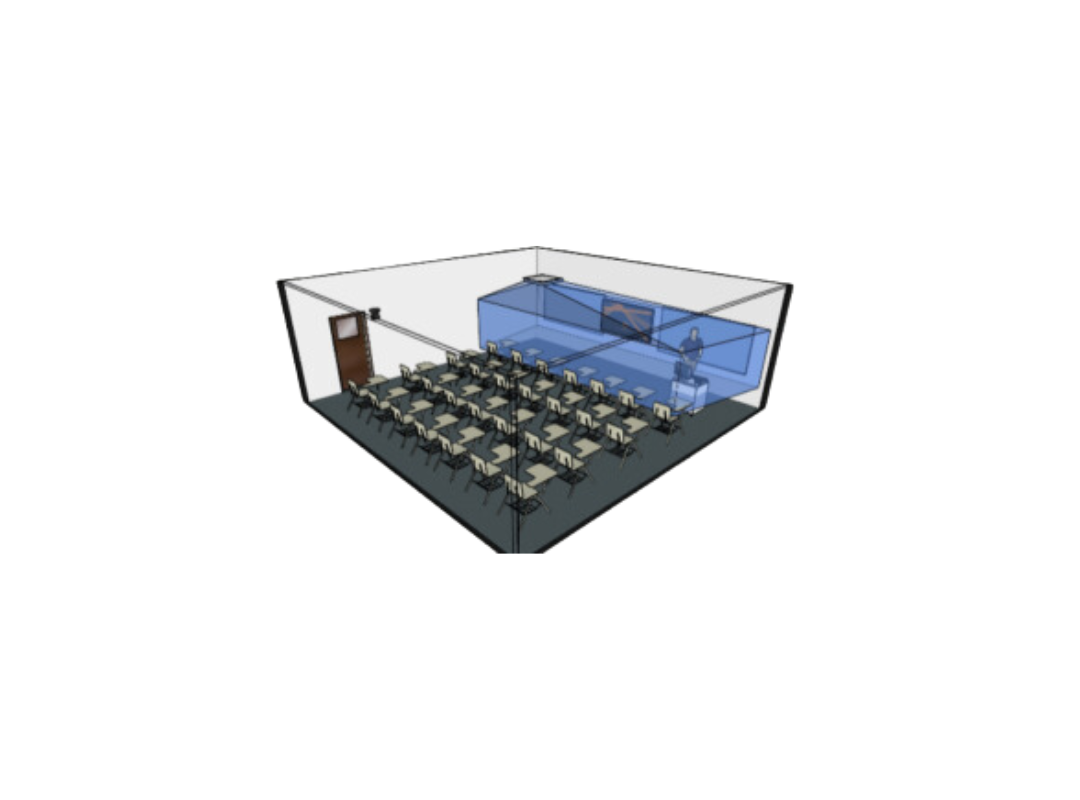Administrators and faculty are feverishly trying to solve the issue of the hybrid flexible (HyFlex) classroom for K-12 and higher education. We all know that in-classroom learning is the best form of learning, but current circumstances dictate that some classrooms cannot accommodate all students.
Public schools, private institutions and colleges are faced with having some, if not all, students participate remotely, which creates the need for a hybrid flexible classroom. All students, whether remote or in-person, need to collaborate with teachers like they are all in the same room. This is a big challenge. In this article, I break down individual obstacles and examine how to solve them with the Front Row Distance Learning Hybrid Classroom Kit.
Check out our short demo video…
Obstacle 1 – In-person and remote student interactivity via video.
This is a challenge if the visual and auditory components in the room are not specifically designed for remote learning. The first step to solving this challenge is to ensure the instructor and the in-class students can see the remote students. The best solution would have the students joining from a Zoom call visible on the main presentation display. The remote students will simultaneously appear on a confidence monitor positioned in the front row. This design focuses the instructor’s attention on all students and creates a more engaging experience for the remote students.
The second interactivity challenge is the classroom camera which should focus on the instructional area and follow instructors as they move throughout this area (shown in blue in the illustration below). The camera tracking feature is required to allow an instructor to freely move at the front of the classroom. However, the camera must also have easily selectable presets to give teachers control to change the focus from whiteboards to lecterns or other presentation tools. The camera angle is of utmost importance for the benefit of the remote experience. To provide a great experience, the camera should be positioned among the classroom students just like the confidence monitor. This viewpoint gives remote students the feeling of sitting in the class.

Obstacle #2 – In-person and remote student audio clarity.
Remote participants should be heard as clearly as the students in the classroom. If a remote student asks a question the sound should be distributed through audio speakers in the room so the instructor and in-class students can hear the question and response. The combination of audio and video allows both in-class and remote participants to pick up on the verbal and non-verbal cues critical to comprehension and understanding.
The classroom microphone system must have exceptional coverage of the entire instructional area to clearly amplify the teacher or professor’s voice. The microphone must also be able to clearly pick up students in a 20-foot x 30-foot classroom. With proper audio processing, the system will filter out unwanted noises and leave only intelligible communication. This allows all students and the instructor to freely engage with one another in conversation.
In addition to audible and video communication, chat features in web-conferencing platforms are shared with all participants. Chat is a great way to queue questions without disrupting a presentation and keep everyone on the same page.
Obstacle #3 – The speed at which instructors can learn new technology.
Any hybrid technology needs to be so simple that teachers and professors can connect with remote students in less than 15 seconds. Technology cannot impede instructional methods—it needs to enhance them. One touch join for classes is the best way to accomplish this, and the best tool for a one touch join is a Zoom Room or Microsoft Teams Room. These web-conferencing systems are pre-programmed to work with calendaring and Learning Management Systems. Instructors can easily connect their classes to a Zoom or Teams meeting in seconds by simply pressing the “Start” button for their class.
Obstacle #4 – The Hybrid Classroom is not a short-term solution.
There is no substitute for in-classroom learning and the education of students is too important for anything less than an optimal learning environment. While none of us knows how long we will be dealing with the current pandemic, these hybrid classroom benefits will last for years to come.
- Zoom and Teams can automatically record classes and recordings can be made available for students to review and study. Access to recordings has been touted as one of the greatest benefits of distance learning, and this benefit should be enhanced.
- No more need to go to class when sick. Having a remote option allows people who are ill to participate even if they can’t attend a class or lecture in-person.
- Travel is not a concern. Students with extenuating circumstances don’t have to miss class if they can remotely dial in or review recorded sessions.
- There are some students who can’t attend regularly scheduled classes because of other activities, e.g. medical appointments, athletics, etc. A Hybrid Classroom provides these students with the ability to call in remotely or watch recorded classes.
It is important to look at the hybrid classroom as an enhancement to education and not a band-aid for the current situation. Our world has changed, and we need to adapt and leap forward.
Obstacle #5 – We don’t have the bandwidth.
Adding new audio and video devices to a school district or university’s network might seem like a daunting task. With careful analysis and systems monitoring, the required additional bandwidth required can be managed. By segmenting the network and creating VLANs for all Zoom devices, you can create Quality of Service plans and allocate a portion of the network’s bandwidth and maintain priority for the most important data crossing the network. In addition, IT staff can quickly pinpoint and adjust trouble areas if education facilities deploy monitoring tools to evaluate jitter, latency and packet loss.
Obstacle #6 – Sharing content and participating in breakout groups.
Most content is accessible from a laptop. Sharing content from Word documents, Excel spread sheets and PowerPoint slides is a feature available to anyone joining the class. Both instructors and students can share relevant content with the entire class for discussion.
Breakout groups are a function in Zoom; however, all platforms continue to develop and advance this functionality as need increases. Instructors can enhance group sessions for in-class and remote participants by creating a room system that allows for movement within the classroom.
Obstacle #7 – Hybrid Classrooms cost too much.
Traditionally, the functionality required for a successful hybrid classroom has been very expensive. Displays, microphones, audio processors, speakers, touch panels and labor for systems to perform the required functions costs well over $15,000. With creativity, development and testing, Radiant Technology’s system builders and programmers have identified ways to deliver a fully functional and effective hybrid classroom kit that costs less than $5,000.
For colleges and universities that provide superior hybrid classrooms, Return on Investment (ROI) is calculated by the number of students retained and new students gained. For K-12 schools, hybrid classroom ROI is measured by educational improvement for remote students and the ability to control the spread of illness throughout the school year.
The Radiant hybrid classroom kit overcomes the 7 obstacles that impact remote learning and delivers a great experience for teachers, professors and all students. This summer, we have converted more than 300 classrooms to hybrid classroom using our custom kits. It’s exciting to help teachers and professors prepare for the return of in-person and remote students this fall. View this 5-minute video to see our hybrid classroom in action.
Schedule your personal demo to see the Radiant hybrid classroom solution first hand. We can accommodate in-person and remote participants. Let us know the time that works best for you.





